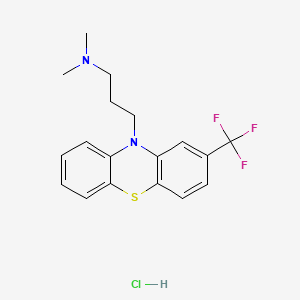



1. Fluopromazine
2. Siquil
3. Trifluopromazine
4. Triflupromazine
1. 1098-60-8
2. Triflupromazine Hcl
3. Flumazin
4. Fluorofen
5. Neoprin
6. Siquil
7. Nivoman
8. Triflupromazine (hydrochloride)
9. Psyquil
10. Vesprin Hydrochloride
11. Triflupromazine Monohydrochloride
12. Trifluopromazine Hydrochloride
13. Fluopromazine Monohydrochloride
14. Mc 4703
15. Nsc-14959
16. Nsc-17473
17. Mls000069672
18. 9e75n4a5hm
19. 10-(3-(dimethylamino)propyl)-2-(trifluoromethyl)phenothiazine Monohydrochloride
20. 10h-phenothiazine-10-propanamine, N,n-dimethyl-2-(trifluoromethyl)-, Monohydrochloride
21. N,n-dimethyl-3-[2-(trifluoromethyl)phenothiazin-10-yl]propan-1-amine;hydrochloride
22. Mc-4703
23. Ncgc00094410-02
24. Smr000058517
25. Vesprin (tn)
26. Dsstox_cid_25804
27. Dsstox_rid_81142
28. Dsstox_gsid_45804
29. 10-(3-dimethylaminopropyl)-2-(trifluoromethyl)phenothiazine Hydrochloride
30. Chebi:9712
31. N,n-dimethyl-2-(trifluoromethyl)-10h-phenothiazine-10-propanamine, Monohydrochloride
32. Nsc14959
33. Nsc17473
34. Wln: T C666 Bn Isj B3n1&1 Exfff
35. N,n-dimethyl-3-[2-(trifluoromethyl)phenothiazin-10-yl]propan-1-amine Hydrochloride
36. Sr-01000000224
37. Triflupromazine Hydrochloride [jan]
38. Einecs 214-149-6
39. Trifluopromazine Hydrochloride (van)
40. Cas-1098-60-8
41. Nsc 14959
42. Nsc 17473
43. Unii-9e75n4a5hm
44. Sr-01000000224-4
45. 10-[3-(dimethylamino)propyl]-2-(trifluoromethyl)phenothiazine Hydrochloride
46. 10h-phenothiazine-10-propanamine,n-dimethyl-2-(trifluoromethyl)-, Monohydrochloride
47. N,n-dimethyl-3-(2-(trifluoromethyl)-10h-phenothiazin-10-yl)propan-1-amine Hydrochloride
48. N,n-dimethyl-3-[2-(trifluoromethyl)-10h-phenothiazin-10-yl]propan-1-amine Hydrochloride
49. Prestwick_893
50. Triflupromazine Hydrochloride [usp:jan]
51. Opera_id_486
52. Fluopromazine Hydrochloride
53. Mls001148408
54. Mls002222277
55. Schembl317144
56. Spectrum1503118
57. Regid_for_cid_66069
58. Chembl1201102
59. Dtxsid8045804
60. Hms1568k07
61. Hms1922g15
62. Pharmakon1600-01503118
63. Hy-b0909
64. Tox21_111276
65. Tox21_501146
66. Mfcd00058103
67. Nsc758387
68. S5565
69. Akos024288004
70. Tox21_111276_1
71. Ccg-213116
72. Lp01146
73. Nsc-758387
74. Phenothiazine, 10-(3-(dimethylamino)propyl)-2-(trifluoromethyl)-, Monohydrochloride
75. Ncgc00016012-12
76. Ncgc00094410-01
77. Ncgc00094410-03
78. Ncgc00094410-04
79. Ncgc00094410-05
80. Ncgc00261831-01
81. Triflupromazine Hydrochloride (jan/usp)
82. Bs-25525
83. Triflupromazine Hydrochloride [mi]
84. Eu-0101146
85. Ft-0736671
86. Sw197014-3
87. T3389
88. Triflupromazine Hydrochloride [mart.]
89. Triflupromazine Hydrochloride [vandf]
90. Triflupromazine Hydrochloride [usp-rs]
91. Triflupromazine Hydrochloride [who-dd]
92. C71345
93. D00800
94. T 2896
95. Triflupromazine Hydrochloride [green Book]
96. Triflupromazine Hydrochloride [orange Book]
97. J-002339
98. Sr-01000000224-2
99. Sr-01000000224-8
100. Triflupromazine Hydrochloride [usp Monograph]
101. Q27108479
102. Z1642388275
103. Triflupromazine Hydrochloride 1.0 Mg/ml In Methanol (as Free Base)
104. Triflupromazine Hydrochloride, Vetranal(tm), Analytical Standard
105. 10-[3-(dimethylamino)-1-propyl]-2-(trifluoromethyl)phenothiazine Hydrochloride
106. Dimethyl({3-[2-(trifluoromethyl)-10h-phenothiazin-10-yl]propyl})amine Hydrochloride
107. N,n-dimethyl-2-(trifluoromethyl)-10h-phenothiazine-10-propanamine Hydrochloride (1:1)
108. Phenothiazine, 10-(3-dimethylaminopropyl)-2-(trifluoromethyl)-, Hydrochloride
109. Triflupromazine Hydrochloride, United States Pharmacopeia (usp) Reference Standard
| Molecular Weight | 388.9 g/mol |
|---|---|
| Molecular Formula | C18H20ClF3N2S |
| Hydrogen Bond Donor Count | 1 |
| Hydrogen Bond Acceptor Count | 6 |
| Rotatable Bond Count | 4 |
| Exact Mass | 388.0987820 g/mol |
| Monoisotopic Mass | 388.0987820 g/mol |
| Topological Polar Surface Area | 31.8 Ų |
| Heavy Atom Count | 25 |
| Formal Charge | 0 |
| Complexity | 416 |
| Isotope Atom Count | 0 |
| Defined Atom Stereocenter Count | 0 |
| Undefined Atom Stereocenter Count | 0 |
| Defined Bond Stereocenter Count | 0 |
| Undefined Bond Stereocenter Count | 0 |
| Covalently Bonded Unit Count | 2 |
Antiemetics
Drugs used to prevent NAUSEA or VOMITING. (See all compounds classified as Antiemetics.)
Antipsychotic Agents
Agents that control agitated psychotic behavior, alleviate acute psychotic states, reduce psychotic symptoms, and exert a quieting effect. They are used in SCHIZOPHRENIA; senile dementia; transient psychosis following surgery; or MYOCARDIAL INFARCTION; etc. These drugs are often referred to as neuroleptics alluding to the tendency to produce neurological side effects, but not all antipsychotics are likely to produce such effects. Many of these drugs may also be effective against nausea, emesis, and pruritus. (See all compounds classified as Antipsychotic Agents.)
Dopamine Antagonists
Drugs that bind to but do not activate DOPAMINE RECEPTORS, thereby blocking the actions of dopamine or exogenous agonists. Many drugs used in the treatment of psychotic disorders (ANTIPSYCHOTIC AGENTS) are dopamine antagonists, although their therapeutic effects may be due to long-term adjustments of the brain rather than to the acute effects of blocking dopamine receptors. Dopamine antagonists have been used for several other clinical purposes including as ANTIEMETICS, in the treatment of Tourette syndrome, and for hiccup. Dopamine receptor blockade is associated with NEUROLEPTIC MALIGNANT SYNDROME. (See all compounds classified as Dopamine Antagonists.)
